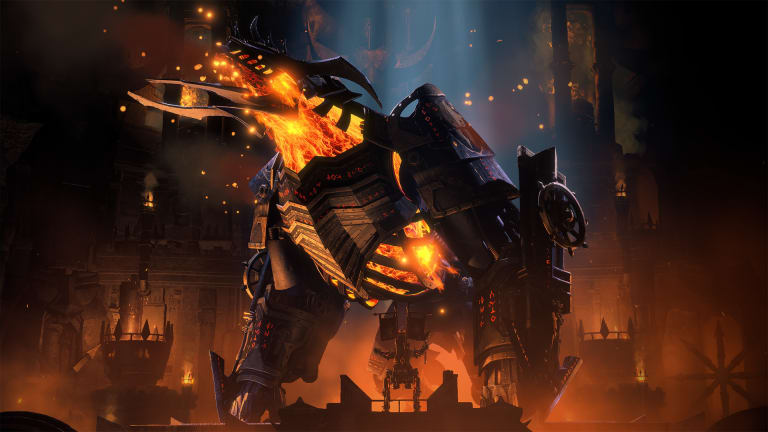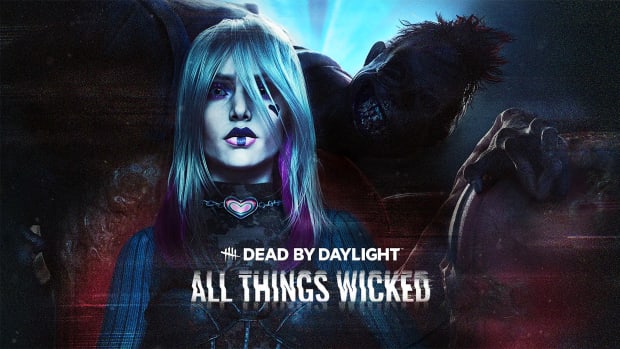
Total War: Warhammer 3 – Forge of the Chaos Dwarfs review

Total War players have controlled many different factions over the years which might be called evil for one reason or another: treacherous Milan, the greedy British, even unwanted Pontus. Creative Assembly’s Warhammer trilogy upped the villain game by letting us play as people like Archaon the Everchosen, whose stated goal is nothing less than to bring about the world’s end. It doesn’t get worse than that, right?
Well, the Forge of the Chaos Dwarfs DLC for Total War: Warhammer 3 manages to one-up the evil factor yet again by giving us control of the most devilish thing imaginable – a mega corporation.
The extensive Warhammer lore would have you believe that the Chaos Dwarfs are a theocratic and industrious society, which came about when Dwarfs that thought themselves abandoned by the rest of their people turned to the minor Chaos god Hashut in desperation for help. Being the god of darkness and other unpleasant things, Hashut assisted these Dawi and in turn twisted their way of living – even their way of being, as Dawi-Zharr sport mutated teeth and some are even born as Bull Centaurs instead of Dwarfs. They learned to bind Daemons to items, imbuing them with powerful and dangerous qualities, and became a cruel race of slavers to fuel their war machine for the day of reckoning, when they would march out of their dark fortresses and take revenge on the ancestors that abandoned them.
The way the Chaos Dwarfs play, though, is less “destructive crusade of revenge” and more “don’t take this personally, it’s just business and I have quotas to fulfill.” Featuring the most complex economy of any Total War: Warhammer 3 faction to date, the Chaos Dwarfs need several resources to function: Gold, Labor, Raw Material, Armaments, and Conclave Influence.
Supporting this economy, the Chaos Dwarfs feature three completely different types of settlements: Towers, which are typical main settlements and generate lots of Conclave Influence and Gold, Outposts, which support mining infrastructure to gain Raw Material and Gold by using Labor, and Factories, which house production facilities to create Armaments and Gold out of Raw Materials.
The foundation for all of this is Labor – and not the well-paid kind with good benefits and safety regulations. Chaos Dwarfs essentially embody the wet dream of capitalism: They don’t even acknowledge their slaves as such, as this would imply that they are living beings instead of what the Chaos Dwarfs see them as – a resource that can be used and replaced at will. Really, that’s what your campaign revolves around when playing them. Labor is gained by enslaving captives after battle, raiding enemy provinces, and exchanging Gold or Armaments for it through the Convoy system. That’s a really well-executed development of the Caravan system of Grand Cathay from the base game and allows the Chaos Dwarfs to balance their economy out by trading for Gold, Raw Materials, or Labor as needed.

Labor must meet the Workload demands of your infrastructure, otherwise efficiency goes down.
Creative Assembly
You need to meet the workforce demands of all your mines to generate Raw Materials and Gold, which in turn is used to create Armaments, more Gold, construct buildings, and conduct research. If you can’t meet these requirements, your economy’s efficiency is going down the drain, reducing the resource output and hampering the development of your settlements and military. Because Labor is going down every turn – especially when Public Order is low – you need a steady supply of it to keep things running. You can also move Labor between provinces and “invest” it to rush building construction, increase Public Order, or immediately gain some Gold. That need, in turn, keeps your armies busy raiding and fighting.
Playing as the Chaos Dwarfs – for the first time in many years of playing Total War – I didn’t have the urge to paint the map and annihilate my enemies, because that would be highly inefficient. If you conquer everyone, who can you work to death in the mines? Convoys only get you so far, so ideally you’ll want to keep some pathetic enemy cities nearby intact (and protected from other factions) to farm or send out expeditions to set up bases for raids far away from your territory. The latter path offers a more interesting playstyle, feels thematic, and is lots of fun.
You’re far more involved in planning out your expansion and economy as the Chaos Dwarfs than as any other faction. Resources and your general economic state have great influence on how you specialize your provinces. If timber or iron are present, for example, you’ll ideally want to make this region a Factory district to use the bonuses provided by those resources – a welcome aspect that’s missing all too often from Total War and should be expanded upon for other races.
Your legendary lords Astragoth Ironhand, Drazhoath the Ashen, and Zhatan the Black are this mega corp’s executives, reporting to the board – the Conclave of Zharr-Naggrund. Each Chaos Dwarf faction can spend Conclave Influence here to gain powerful bonuses by occupying seats. There are interesting cooperative elements here, as factions can work together to fill out a certain district and so unlock the next tier of seats. However, you can also spend Conclave Influence to usurp another faction’s seats and steal those coveted bonuses from them. Coming out on top of this juggle for power inside the Conclave rewards you with opportunities to confederate with the other Chaos Dwarf factions, reuniting all the Zharr-Naggrund mega corp’s different subsidiaries.
Another unique faction mechanic the Chaos Dwarfs offer is the Hell-Forge, where you spend your Armaments on increasing the unit capacity for Chaos Dwarf units and upgrading them with powerful abilities, which feels good and is, again, super thematic for the master smiths. There aren’t that many Chaos Dwarfs, so they fill out their armies by conscripting Greenskin Laborers and hiring Hobgoblins as auxiliaries. These make up the large majority of your troops early on, which leads to interesting battle dynamics – these units have questionable loyalties and easily run away when hard-pressed, so you have to deal with some Skaven-like micromanagement to get them back into battle as your few Chaos Dwarfs anchor the line.
They make up for those low numbers with good base stats, superb aesthetics – we’re talking impressively mighty hats here – and those upgrades from the Hell-Forge, which need to be maintained by continuously investing Armaments. They can field some of the coolest war machines in Total War: Warhammer 3 as well, such as the Iron Daemon – a locomotive with cannons – and the Dreadquake Mortar, and command the might of the K’Daai Destroyer, which might take the cake for most badass-looking monster in the entire series so far. Add to that the new Lore of Hashut, which has awesome synergies with the reworked Lore of Fire, and you have a complete-feeling faction in battle as well as on the campaign map.
Forge of the Chaos Dwarfs does a lot to enhance both the Realms of Chaos and Immortal Empires maps by filling out the empty hole that was previously found in the Darklands between West and East, adding much-needed variety to the opponents you face there.
The narrative Realms of Chaos campaign created for the Chaos Dwarfs is up there with the fun storyline from the Champions of Chaos DLC last year, as you’re tasked with putting together a mighty drill to tear through the fabric of reality itself and collect the blood of your god – the ultimate resource. You need to collect a bunch of ancient relics for that purpose, binding some Daemons to them in an act of sacrilege that won’t be forgiven by your Dwarfen cousins, who will try to stop you from achieving your goal. You can influence how the campaign’s final battle turns out by choosing which relics you go after, so the grand finale reflects your decisions up to this point. This is something fans have wanted for a while now, and it’s nice to see that Creative Assembly has listened to those wishes.
Each legendary lord has his own motivation for going along with that plan as well, and that’s woven into the narrative at least a bit, which is cool for the role-players among us. Drazhoath, for example, has been exiled from Zharr-Naggrund for a long time and seeks this as a chance to prove himself worthy of not just coming back into the fold, but taking over from what he sees as old and inept leadership.
What the DLC doesn’t – and, admittedly, probably isn’t supposed to do by itself – is ironing out the issues plaguing Total War: Warhammer 3 for a while now: Among those are the bugged Chaos Corruption visuals on the map, subpar siege battles and ridiculously weak garrisons that might as well be wet paper towels, and an AI that will happily give up its main territory for the simple pleasure of annoying the hell out of you by sacking your settlements (which you have no chance of defending thanks to those pathetic garrisons), taunting you as it rides into the sunset in Forced March stance while just staying out of your range each turn as you helplessly follow it. While the DLC’s new content and mechanics are a fantastic addition, I’m held back from fully enjoying them because of what the game’s foundations are lacking.
Looking at it by itself, the Forge of the Chaos Dwarfs DLC is another love letter to Warhammer Fantasy, doing justice to a highly-anticipated faction, and evolving the gameplay formula in a good direction on the campaign map with interesting mechanics. Glory to the military-industrial complex, glory to Hashut!
Score: 8/10
Tested on PC.




